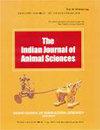Boiled potato waste silage as an alternate roughage for goats
IF 0.3
4区 农林科学
Q4 AGRICULTURE, DAIRY & ANIMAL SCIENCE
引用次数: 0
Abstract
A feeding trial (60 days) was conducted to gauge the nutritional attributes of boiled potato (Solanum tuberosum) peel waste silage and to analyse its feeding effect on intake and utilization of nutrients in goats. Twelve local, non-descript, adult male goats were randomly divided into two groups. Each group was given ad lib. wheat straw, concentrate mixture @ 20 g/KgW0.75 and silage @ 75 g/KgW0.75 Based on variation in source of silage the groups were classified as maize silage (MS) or potato peel waste silage (PPS) groups. Despite the higher crude protein concentration PPS could be successfully ensiled with achievement of necessary pH fall, possibly due to effect of boiling on starch granules to render it readily fermentable and/or heat damaged CP. In both the groups live weight of the goats was maintained throughout the trial. The PPS formed about 20.2% of the total ration intake (on DM basis). Nutrient digestibility (%) was similar between dietary groups, except NFE and NDF digestibility, which was considerably higher in PPS group. It may be concluded that the ensiled boiled potato peel waste may be utilized as a constituent of adult goat ration without compromising nutrient intake, digestibility, plane of nutrition and nutrient balance.煮马铃薯废青贮料作为山羊的替代粗饲料
通过饲喂试验(60 d),测定水煮马铃薯(Solanum tuberosum)皮废青贮的营养特性,分析其对山羊采食量和营养物质利用的影响。选取12只当地无特征的成年公山羊,随机分为两组。每组都是随机分配的。小麦秸秆、精料混合物@ 20 g/KgW0.75和青贮@ 75 g/KgW0.75根据青贮来源的不同分为玉米青贮(MS)组和马铃薯皮废青贮(PPS)组。尽管粗蛋白质浓度较高,但PPS可以成功青贮,达到必要的pH值下降,这可能是由于煮沸对淀粉颗粒的影响,使其易于发酵和/或热损伤CP。在整个试验过程中,两组山羊的活重都保持不变。PPS约占口粮总摄入量的20.2%(以日粮计)。除NFE和NDF消化率以PPS组较高外,各组间营养物质消化率基本一致。综上所述,青贮水煮马铃薯皮废料在不影响营养摄入量、消化率、营养平面和营养平衡的情况下可作为成年山羊日粮的组成部分。
本文章由计算机程序翻译,如有差异,请以英文原文为准。
求助全文
约1分钟内获得全文
求助全文
来源期刊

Indian Journal of Animal Sciences
农林科学-奶制品与动物科学
CiteScore
0.60
自引率
25.00%
发文量
220
审稿时长
8 months
期刊介绍:
Articles published in The Indian Journal of Animal Sciences encompass a broad range of research topics in animal health and production related to cattle, buffalo, sheep, goat, camel, equines, pig, rabbit, yak, mithun, poultry and fisheries. Studies involving wildlife species and laboratory animal species that address fundamental questions about their biology will also be considered for publication. All manuscripts must present some new development and must be original, timely, significant and scientifically excellent. Papers will be rejected if standards of care of, or procedures performed on animals are not up to those expected of humane veterinary scientists. At a minimum, standards must meet the International Guiding Principles for Biomedical Research involving Animals, as issued by the Council for International Organizations of Medical Sciences. (C.I.O.M.S., c/o WHO, CH 1211 Geneva 27, Switzerland). Articles reporting new animal disease must follow GOI directive as given in detail in Guidelines to Authors.
 求助内容:
求助内容: 应助结果提醒方式:
应助结果提醒方式:


